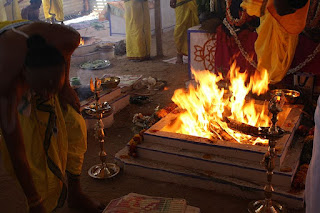Missing of a prominent river from the map is not a mystery; it is quite natural as the
natural phenomena evolve through environmental changes.
A part of the river Saraswati till now exists as Ghaggar in Haryana, the rest of it has disappeared in the fringes of the Marusthali or the Thar Desert.
Bhabha Atomic Research Centre, Mumbai has made a breakthrough in its research for the existence and probable location of the mythical Saraswati river. The Rajasthan Ground Water Department undertook the task to ‘unearth’ the river with the collaboration of BARC and Physical Research Laboratory, Ahmedabad (a wing of ISRO) in 1998.
If the effort is successful, the people living in the desert belt of Rajasthan will be hopefully supplied more than 3500 year old water derived from palaeo-channels, believed to be the mythical Saraswati.
A part of the river Saraswati till now exists as Ghaggar in Haryana, the rest of it has disappeared in the fringes of the Marusthali or the Thar Desert.
Bhabha Atomic Research Centre, Mumbai has made a breakthrough in its research for the existence and probable location of the mythical Saraswati river. The Rajasthan Ground Water Department undertook the task to ‘unearth’ the river with the collaboration of BARC and Physical Research Laboratory, Ahmedabad (a wing of ISRO) in 1998.
If the effort is successful, the people living in the desert belt of Rajasthan will be hopefully supplied more than 3500 year old water derived from palaeo-channels, believed to be the mythical Saraswati.
Being one of the chief Rigvedic Rivers, as per the Hindu scripts and
texts, Saraswati River is also famously known as Ghaggar-Hakra River.
The Saraswati River is mentioned between the east of Yamuna and west of
Sutlej in the early Rigvedic 'Nadistuti' hymn.
But later in the other Vedic scriptures it is said that the Saraswati
River dried up in a desert. This river is a trans-boundary to India as
well as to Pakistan. Also this river flows through both the nations
together only in the monsoon.Several palaeo-channels of river have been identified in the region of Rajasthan, Haryana, Uttar Pradesh and adjacent areas, some of which are assigned to the Saraswati. The river is considered to have migrated from east to west. But in the past, most discussions have pointed to the river being in north Gujarat.
 |
| Course of Sarasvati river |
For 2000 years, between 6000 and 4000 B.C., the Saraswati flowed as a great river. R. D. Oldham (1886) was the first geologist who argued logically pointing to the great changes in the drainage pattern of the rivers of Punjab and western Rajasthan converting a once fertile region into a desert. According to geological and glaciological studies, the Saraswati was supposed to have originated in Bandapunch massif (Saraswati-Rupin glacier confluence at Naitwar in western Garhwal).
 |
| Map of northern India in the late Vedic period |
 |
| Painting of Goddess Saraswati by Raja Ravi Varma |
Etymology : Sarasvatī is the devi feminine of an adjective sarasvant- (which occurs in the Rigveda as the name of the keeper of the celestial waters), derived from Proto-Indo-Iranian *sáras-vant-ī (and earlier, PIE *séles-u̯n̥t-ih₂), meaning ‘marshy, full of pools’.
Sanskrit sáras means ‘pool, pond’; the feminine sarasī́ means ‘stagnant pool, swamp’. Like its cognates Welsh hêl, heledd ‘river meadow’ and Greek ἕλος (hélos) ‘swamp’, the Rigvedic term refers mostly to stagnant waters, and Mayrhofer considers unlikely a connection with the root *sar- ‘run, flow’.
Sarasvatī is an exact cognate with Avestan Haraxvatī, perhaps originally referring to Arədvī Sūrā Anāhitā (modern Ardwisur Anahid), the Zoroastrian mythological world river, which would point to a common Indo-Iranian myth of a cosmic or mystical Sáras-vant-ī river. In the younger Avesta, Haraxvatī is Arachosia, a region described to be rich in rivers, and its Old Persian cognate Harauvati, which gave its name to the present-day Hārūt River in Afghanistan, may have referred to the entire Helmand drainage basin (the center of Arachosia).
a related reference:
kumbh mela of allahabad india
a related reference:
kumbh mela of allahabad india






























.jpg)











